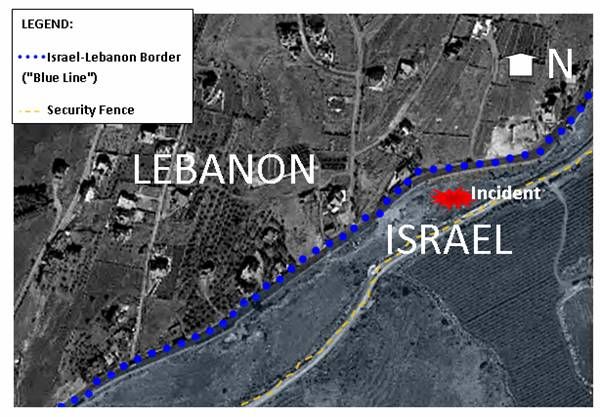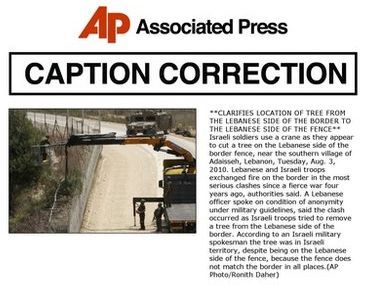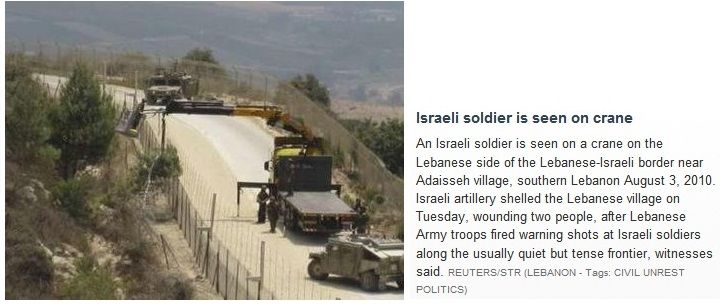A fatal exchange of fire between Lebanese soldiers and the IDF on Israel’s northern border has left one Israeli soldier dead along with 4 other fatalities on the Lebanese side. The incident also raises questions concerning the integrity of the media that covered the events.
Lebanese forces opened fire on IDF soldiers performing routine maintenance work by the security fence near the border. The IDF soldiers were clearing bushes to improve the line of sight over the border and to prevent Hezbollah terrorists from hiding in the undergrowth and carrying out an attack or kidnapping. The routine work had been cleared in advance with UNIFIL.
It is vital to note that the UN demarcated Blue Line that marks the official border between Israel and Lebanon does not always follow the route of the security fence. While the IDF was operating over the fence, it was still within Israeli territory as seen on the map below.

Wire Services Get it Wrong
As is so often the case in any incident involving Israel, official Israeli statements were ignored in favor of Lebanese accusations that the IDF had crossed into Lebanese territory, a theme taken up by wire services such as
Reuters, which describes the crane being located on the Lebanese side of the border.
Similarly, the Associated Press also wrongly stated the location for many hours after the incident before issuing the following update:

If wire service photographers were at the scene near the security fence, did they really not know where they were located?
Despite the caption correction, a number of media outlets are still using erroneous captions, including
The Daily Telegraph, while
The Independent even stated that the incident had occurred “on the Lebanese side of the border
in the southern village of Adaisseh.”
How and Why Were the Photographers There?
An
AP report on the incident places Ronith Daher, a Lebanese journalist and the photographer of the above image, at the scene. Evidently, someone from Reuters was also there to take the previous image.
But why were they there in the first place taking photographs before the incident even occurred?After all, pruning foliage is hardly headline news on an ordinary day unless something out of the ordinary was expected. UNIFIL and through it, the Lebanese Army, had been notified of the IDF’s routine maintenance and even UNIFIL now admits that the Lebanese fire
was unwarranted.
Also according to AP, a Lebanese journalist with the daily Al-Akhbar newspaper, Assaf Abu Rahhal, was killed when an Israeli shell landed next to him in the border village of Adeisseh. Al-Akhbar is reportedly associated with Hezbollah and has been denounced by Lebanese Druze leader Walid Jumblatt as being funded by Syria and Iran. So what was Abu Rahhal doing in the area exposing himself to IDF counter-fire?
A Reuters photographer was also on the scene in Adeisseh capturing the moments in the immediate aftermath of the IDF retaliation that led to the deaths of Abu Rahhal and three Lebanese soldiers.
Again, we ask how it was that a Reuters photographer was so conveniently on the scene at such an opportune moment.
It is an open secret that parts of the Lebanese Army have been infiltrated by Hezbollah sympathisers and operatives. So information shared by Israel with UNIFIL and the Lebanese Army invariably finds its way to Hezbollah.
Was this incident a staged and pre-planned ambush as evidenced by the presence of photographers and journalists even before the exchange of fire? Were these journalists there precisely because they had advance notice of a potential flashpoint?
A Simple Narrative Ignored by the Media
Many media outlets, including the
BBC, have given equal or more weight to Lebanese claims surrounding the nature of the incident despite the overwhelming evidence.
CNN stated that “Two separate narratives emerged about the incident.” Commenting on the media coverage, particularly from the
New York Times,
Barry Rubin says:
The truth, however, is easy to ascertain–did Israel announce the maintenance, permit the photographers and UN people to watch and then cross deliberately into Lebanon?–but Israel is being portrayed as an aggressor that caused the outbreak of fighting. So millions of people will either believe that Israel was at fault or that the event is in question.The narrative, however, is simple: In an unprovoked attack, Lebanese soldiers fired on Israelis and murdered one soldier.
Watch out for incorrectly captioned photos and ina
ccurate stories in your local media outlets and take action to secure corrections and amendments.
Update – 5 August





